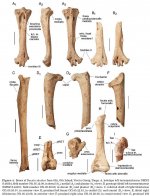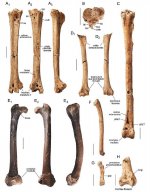Fred Ruhe
Well-known member

TREVOR H. WORTHY and DAVID V. BURLEY, 2019
Prehistoric avifaunas from the Kingdom of Tonga
Zoological Journal of the Linnean Society, 2019, XX, 1–48. With 5 figures
Free pdf: https://watermark.silverchair.com/z...SRjknchdsFOqdSXuzPmKmgZQ1ATkZujth36fV9GKl-t7A
Abstract:
Avifaunas derived from Lapita archaeological sites excavated between 2004 and 2014 from four sites in the Vava'u Group and two on Tongatapu, Kingdom of Tonga are described, revealing birds encountered by the first human arrivals. A total of 741 identifiable bones revealed 24 avian taxa, among which terrestrial birds, especially rails, pigeons and parrots, were the most abundant. At a minimum, eight taxa, or 50% of the original non-passerine land bird diversity in the sample, are globally extinct. These include two megapodes (Megapodius alimentum and a larger unnamed megapode), three pigeons (a large Caloenas sp. indet., Didunculus placopedetes and Ducula shutleri sp. nov.), two rails (Hypotaenidia vavauensis sp. nov. and an unnamed one) and the parrot Eclectus infectus. The rail H. vavauensis was restricted to Vava'u and was flightless, with reduced wings, and larger than Hypotaenidia
woodfordi of the Solomons, the largest congener hitherto found in the Pacific. The pigeon Du. shutleri was volant, but was the largest species in its genus and was widespread in the Kingdom. The evolution of Tongan avifaunas is related to varying ages (Pliocene to Pleistocene) of the island groups, where geological youth apparently precluded true giantism in the fauna.
Enjoy,
Fred
Prehistoric avifaunas from the Kingdom of Tonga
Zoological Journal of the Linnean Society, 2019, XX, 1–48. With 5 figures
Free pdf: https://watermark.silverchair.com/z...SRjknchdsFOqdSXuzPmKmgZQ1ATkZujth36fV9GKl-t7A
Abstract:
Avifaunas derived from Lapita archaeological sites excavated between 2004 and 2014 from four sites in the Vava'u Group and two on Tongatapu, Kingdom of Tonga are described, revealing birds encountered by the first human arrivals. A total of 741 identifiable bones revealed 24 avian taxa, among which terrestrial birds, especially rails, pigeons and parrots, were the most abundant. At a minimum, eight taxa, or 50% of the original non-passerine land bird diversity in the sample, are globally extinct. These include two megapodes (Megapodius alimentum and a larger unnamed megapode), three pigeons (a large Caloenas sp. indet., Didunculus placopedetes and Ducula shutleri sp. nov.), two rails (Hypotaenidia vavauensis sp. nov. and an unnamed one) and the parrot Eclectus infectus. The rail H. vavauensis was restricted to Vava'u and was flightless, with reduced wings, and larger than Hypotaenidia
woodfordi of the Solomons, the largest congener hitherto found in the Pacific. The pigeon Du. shutleri was volant, but was the largest species in its genus and was widespread in the Kingdom. The evolution of Tongan avifaunas is related to varying ages (Pliocene to Pleistocene) of the island groups, where geological youth apparently precluded true giantism in the fauna.
Enjoy,
Fred





